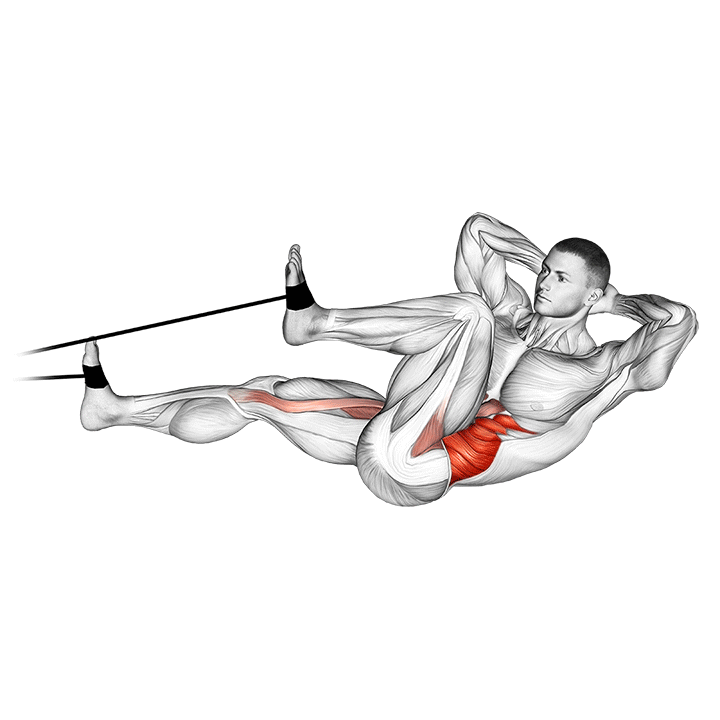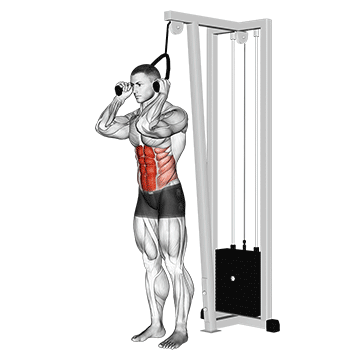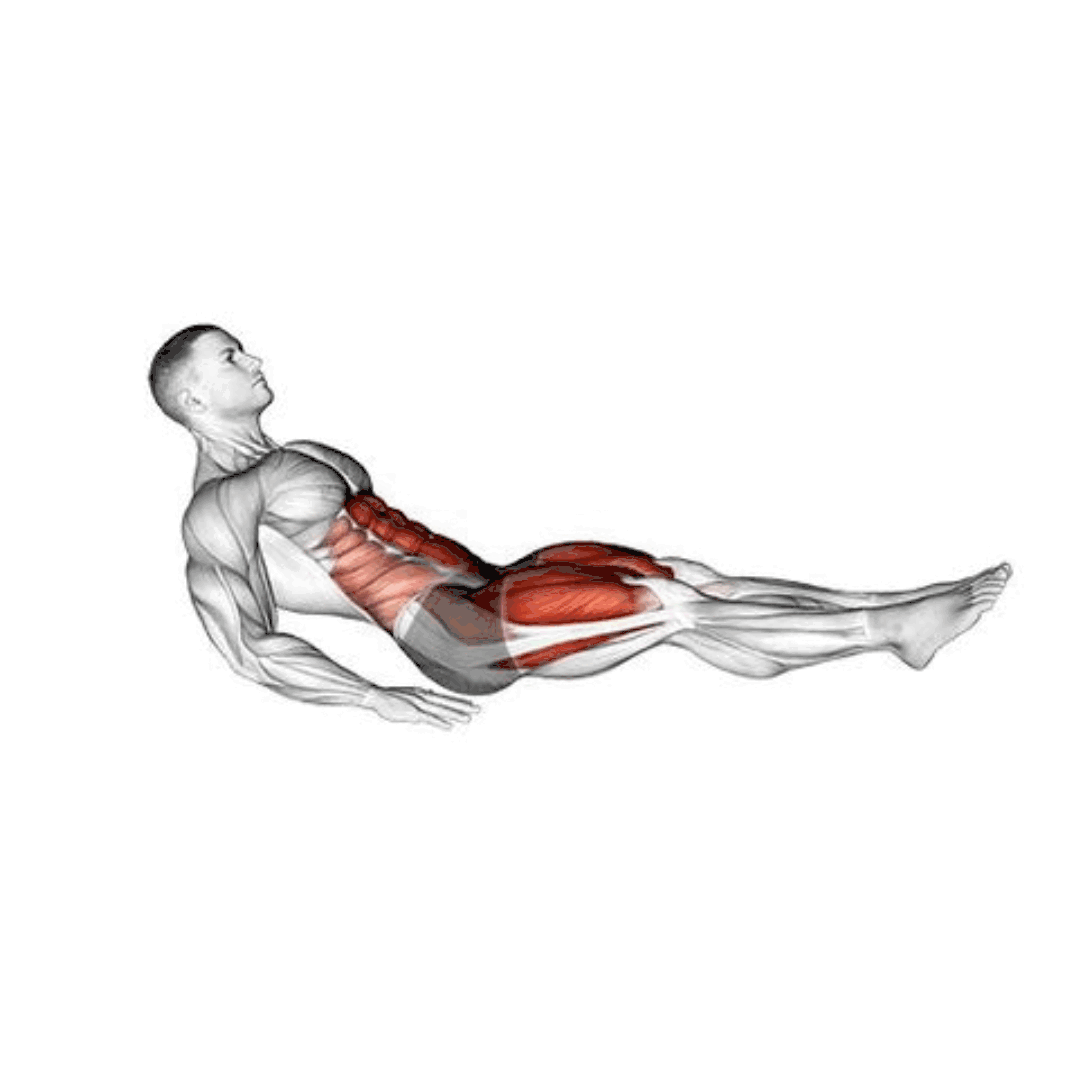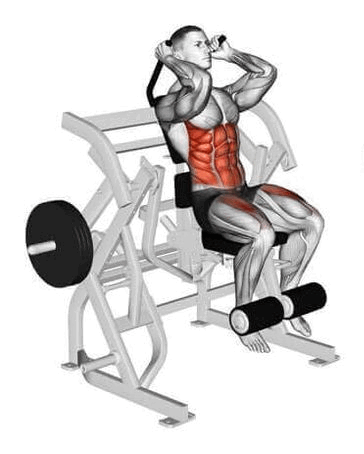BICYCLE CRUNCH

The bicycle crunch is a highly effective exercise for targeting the abdominal muscles, particularly the obliques, and enhancing core strength.
- How to Perform Bicycle Crunches
STARTING POSITION
- Lie flat on your back on a mat with your hands placed behind your head. Lift your head, shoulders, and legs off the ground, and bend your knees to form a 90-degree angle.
MOVEMENT
- Bring your right elbow towards your left knee while extending your right leg out straight.
- As you bring your elbow and knee together, twist your torso to engage your obliques.
BREATHING
- Exhale as you twist and bring your elbow towards your knee, and inhale as you return to the starting position
REPETITIONS
- Perform the movement in a controlled, alternating manner for 15-20 repetitions per side, or as many as you can maintain with proper form
CABLE CRUNCH

The cable crunch is a strength training exercise that targets the abdominal muscles, particularly the rectus abdominis (the "six-pack" muscles), by utilizing resistance from a cable machine. This exercise is highly effective for building core strength and adding definition to the abs
- How to Perform Cable Crunches
STARTING POSITION
- Attach a rope handle to a high pulley on a cable machine.
- Kneel in front of the machine and grab the rope with both hands, placing your hands on either side of your head or near your forehead.
MOVEMENT
- Keeping your hips stationary, contract your abs and curl your torso down toward the floor, bringing your elbows toward your thighs.
- Focus on using your core muscles to drive the movement rather than your arms or hips.
- Hold the contraction at the bottom of the movement for a brief second, squeezing your abs.
- Slowly return to the starting position by extending your torso back up, maintaining control of the cable resistance.
BREATHING
- Exhale as you crunch downward and engage your abs.
- Inhale as you return to the starting position.
REPETITIONS
- Aim for 10-15 controlled reps per set, depending on your fitness level and resistance
CRUNCHES

Crunches are a popular and effective bodyweight exercise that primarily targets the abdominal muscles, specifically the rectus abdominis (the "six-pack" muscles). They are commonly used in core workouts to improve abdominal strength and endurance
- How to Perform Crunches
STARTING POSITION
- Lie flat on your back on a mat or exercise surface.
- Bend your knees and place your feet flat on the ground, about hip-width apart.
- Place your hands behind your head or across your chest. Avoid pulling on your neck if your hands are behind your head.
EXECUTION
- Engage your core by pulling your belly button towards your spine.
- Lift your head, shoulders, and upper back off the ground, curling your torso towards your knees.
- Keep your lower back pressed into the mat and avoid using your arms or neck to lift your torso.
- Squeeze your abdominal muscles at the top of the movement for a brief pause.
RETURN TO POSITION
- Slowly lower your upper body back to the mat, maintaining control and keeping your core engaged.
- Avoid letting your shoulders touch the ground before starting the next repetition to keep tension on the abs.
BREATHING
- Exhale as you lift your torso and inhale as you return to the starting position.
HANGING KNEE RAISES

Hanging knee raises are an effective core exercise that targets the abdominal muscles, particularly the lower abs, and also engages the hip flexors. They are performed while hanging from a bar, which also helps to improve grip strength and shoulder stability
- How to Perform Hanging Knee Raises
SETUP
- Find a sturdy pull-up or chin-up bar. Grip the bar with your hands shoulder-width apart and allow your body to hang with your arms fully extended.
- Keep your legs straight and slightly bent at the knees. Engage your core and keep your shoulders down and away from your ears.
EXECUTION
- Begin the movement by lifting your knees towards your chest. Focus on using your abdominal muscles to lift your legs, rather than swinging your body or using momentum.
- Raise your knees as high as possible, ideally bringing them towards your chest. Avoid rounding your lower back excessively.
- Squeeze your abs at the top of the movement for a brief pause.
RETURN TO POSITION
- Slowly lower your legs back to the starting position, maintaining control and keeping tension in your core throughout the descent.
- Avoid letting your feet touch the ground or swinging your legs; keep the movement controlled and smooth.
BREATHING
- Exhale as you lift your knees and inhale as you lower them back down.
MACHINE CRUNCHES

Machine crunches are a core exercise performed using a specialized abdominal crunch machine. This exercise targets the rectus abdominis (the "six-pack" muscles) and can be a great way to isolate and strengthen the abdominal muscles with added resistance.
- How to Perform Machine Crunches
SETUP
- Adjust the seat and the handle or pad height on the machine so that your knees are bent at a 90-degree angle when you sit on the seat, and your feet are flat on the floor.
- Position your upper body against the back pad and grip the handles (if available) or place your hands behind your head or across your chest.
STARTING POSITION
- Sit upright with your back against the pad and your core engaged. Make sure your feet are firmly planted on the floor and your knees are aligned with the machine’s pad or handles.
EXECUTION
- Engage your abdominal muscles and curl your torso towards your knees by flexing your spine.
- Use your abs to pull your upper body forward, aiming to bring your chest towards your knees. Avoid using your arms or shoulders to assist with the movement.
- Squeeze your abs at the peak of the crunch for a brief moment.
RETURN TO POSITION
- Slowly lower your upper body back to the starting position in a controlled manner, maintaining tension in your abs throughout the descent.
- Avoid letting your shoulders relax completely or your back touch the pad fully before the next repetition.
BREATHING
- Exhale as you crunch forward and inhale as you return to the starting position.
